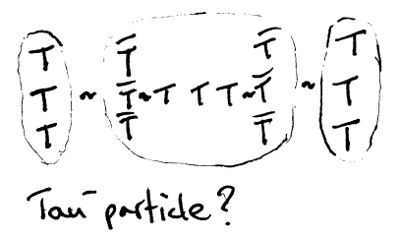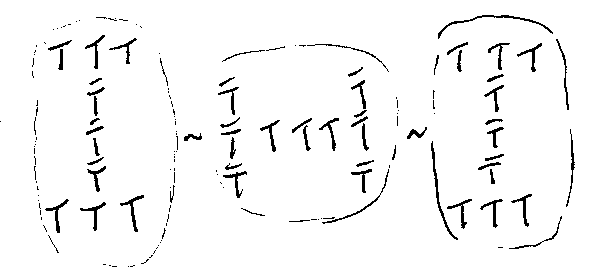Next: Quark Flavours Up: Expanded Rishon Model Particles Previous: Rishon "I" Frame Contents
Note that all of these sixteen particles respect the I-Frame rules: central Rishon particle of the end triplets is attracted to the end Rishons of the middle triplet. Under this extended Rishon Model there are not anticipated to be any other 9-Rishon particles like this. The only possibility is that a further tripling might be considered. One possibility is that the tau is in fact one such multi-level I-Frame within an I-Frame particle:
 figurePossible multi-level I-Frame candidate for Tau-
figurePossible multi-level I-Frame candidate for Tau-
|
In this picture is shown in effect a muon - itself an I-Frame particle - in the central position of an outer I-Frame, with two surrounding positrons. Given that Tau particles were detected in experiments from 1974 to 1977 using electron-positron colliders, it makes an inordinate amount of sense that the Tau would in fact be comprised, internally and exclusively, of electrons and positrons. Re-examining the original data, if the energies were sufficient, there may be evidence for the following particle as well:
 figurePossible multi-level I-Frame undiscovered particle?
figurePossible multi-level I-Frame undiscovered particle?
|
Looking closely at the arrangement here: although the two outer muons overall have a +1 T charge, the centre of those two outer muons comprises a positron, which is exactly what the outer particles of the inner muon are: also positrons. Thus we conclude that this particle would be highly unstable.
Also a very remote outside possibility to consider would be three muon+ particles, with attraction of the ends of the middle attracting to the middle of the outers (the basic I-Frame pattern). Two things mitigate against this, though: first is the total charge of +3, and second would be that the ends of the outer muons would be too close to the ends of the inner muon. With all the end particles being positrons it's hard to imagine how the repulsive forces would permit these to remain in close proximity. This paradox is explored later (see section on proton-neutron proximity).
There may also exist combinations involving a central single TTT or anti particle (electron or positron) surrounded in effect by a pair of muons. However as the size of the muons (as well as their mass / energy) would dwarf that of the electron in the centre of the outermost I-Frame it seems intuitively quite unlikely that such a particle would exist (or if it did, it would be exceptionally unstable). Additional factors mitigate against the existence of such a particle: how would the central electron be able to rotate freely, when surrounded by two muons? The more consideration is given to this muon-electron-muon I-Frame layout, the less likely it seems to be practical.
That does not however entirely rule out the possibility of other double-stacked I-Frame layouts. This will be dealt with later.
lkcl 2016-12-29